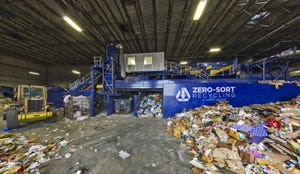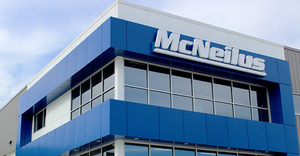It's the Spec, Not the Check
Buying a new refuse truck is about more than sticker price. Spec a vehicle that offers the lowest possible cost over the long run.

Proper life cycle cost management for refuse trucks may seem like a very old saw in the waste business — a theme harped on again and again — but it's a mantra that's taken on new importance in the current economic crisis. And the key to effective life cycle cost control can be boiled down to two words: “component specification.”
Roy Svehla, senior manager of fleet maintenance for Phoenix-based Republic Services, says the vast changes in truck design in the last few years — driven largely by strict new emission regulations — put a premium on good spec'ing strategies.
“The last five years have been unprecedented in the trucking industry,” Svehla says. “New emissions equipment has put extreme pressure on vehicle specs. Additionally, the extra weight of emissions equipment negatively impacts payload capacity, with chassis layouts changing to accommodate additional emissions-related hardware. As a result, the specification process has become more challenging and more critical in the last couple of years.”
Chassis prices rose in 2007 and will do so again with the upcoming 2010 federal emission regulations. Spec'ing longer-lasting components and using warranties can help offset those increased costs, Svehla adds.
The Right Mix
For Svehla, effective spec'ing is fairly simple. It's a process of finding the balance point between service and cost, while trying to standardize the vehicle as much as possible.
“We are developing standardized vehicle specs that are consistent with industry standards and designed to meet the extreme demands of our business,” Svehla says. Republic is trying to standardize axle weights and horsepower ratings as much as it can to save money at the front end when purchasing as well as through the life of the trucks through more unified maintenance practices.
“Reducing the number of chassis/body combinations is paramount in our specification process,” says John Lemmons, director of fleet and equipment performance for Houston-based Waste Management.
More standardized and thought-out specs give refuse fleets more options as their equipment ages, says Darry Stuart, president of Wrentham, Mass.-based DWS Fleet Management Services, a firm specializing in fleet maintenance issues. “When you go to buy a new truck these days, you should spec it to last 10 years at least,” he says. “You may think you're going to keep it for only eight years, but if you reach year eight and you're in an economy like we're in now, you'll want to be able to run it another year or two. That's the flexibility a properly thought-out spec'ing strategy gives you.”
Investing, Not Spending
When spec'ing a vehicle, it is important to remember that the lowest-priced equipment does not always provide the lowest costs over the long term, Lemmons says. One mental “trick” that Svehla uses to get around the natural anathema to spending money on new trucks in a down economy is to replace the word “spend” with “invest.”
“It's all about changing your viewpoint,” he says. “Instead of looking at the spec'ing process as ‘spending’ money, you flip it around and view it in terms of ‘investing’ money, as in ‘if I invest in X-Y-Z component, how does that improve my return over the life of the vehicle?’”
He uses synthetic fluids as an example. Investing in the highest grade synthetic hydraulic or transmission fluids yields not only longer service intervals — lowering maintenance costs — but also extends warranty coverage from the manufacturer. That measurable return comes as an opportunity for investment, Svhela says.
“There's a direct correlation between the specs you choose to keeping that truck on the street,” Stuart says. “You can't skimp on your specs if you expect to see a return on your investment, and that return is uptime.”
The other return on the right spec'ing investment is a vehicle that is better equipped to deal with the broad impact that emission regulations are having on truck designs, Lemmons says. The federal 2007 emission requirements have added several hundred pounds of equipment to trucks. Consequently, “we have had to address body placement, chassis wheelbase and body capacities in order to optimize the payload while at the same time maintaining compliance” with regulations such as those for gross axle weight and gross vehicle weight, Lemmons explains.
The upcoming 2010 emission requirements will require haulers to make additional changes to truck specs.
“In this day and age of tight emission regulations, rising steel prices, and high fuel costs, it's a tough situation as it makes refuse trucks more expensive,” Stuart says. “You can't raise fees fast enough to cover escalating costs — everyone is scrambling to get margins — so the only way to generate more revenue is to make the truck last longer.”
A “Holistic” Approach
Republic takes a “holistic” approach to spec'ing, looking at all the influences on a refuse truck over its expected life, from maintenance to driver comfort — even the support suppliers provide for their components in the field.
“Chassis life, operating and procurement costs, maintenance costs, driver ergonomics, safety, environmental compliance and dealer support are all factored into the equation when we make our purchasing decisions,” Svehla says. “We value the partnerships we have with our vendors and by working together we strive to develop equipment that serves our business from cost (procurement plus repair and maintenance), service (operations) and maintenance perspectives.”
Svehla adds that Republic is implementing a more robust preventative maintenance system, aimed at increasing uptime and reducing unscheduled repairs.
The focus for the refuse fleet manager is where to spend — and where not to spend — maintenance dollars over the life of the vehicle to reach that 10- or 12-year mark, Stuart says. If you do proper, consistent maintenance on items such as brakes, tires, the engine and the hydraulic systems on the body, a 10-year life is easy to obtain, though there may be some metal fatigue on the chassis frame, depending on how hard the vehicle is used.
“Just focusing on the basics consistently will save you money over the life cycle of the vehicles,” Stuart says. “Take tires, for example. I'm working with one fleet that reduced tire costs by 25 percent in one year simply by focusing on good maintenance practices — maintaining proper tire pressure, inspecting for damage, proper rotation, balance, and alignment. Brake costs for them are also way down because we upgraded the type of brake shoe they used — a shoe that is stronger and lasts longer, thus resulting in less maintenance and fewer breakdowns.”
Lemmons notes that WM's calculations include the following considerations: service support after sale; total cost of ownership; and a combination of fuel economy, ease of maintenance and reduced down time. Finally, there's the issue of truck weight to address, critical due to tighter emission regulations that are forcing additional and heavier components onto refuse trucks, reducing available payload.
“Truck capacity is limited by weight, not number of customers or volume, as we typically weigh out before we cube out,” Svehla says. “We want to take full advantage of every ounce of legal payload, and that's why spec'ing has become so much more challenging over the last couple of years.”
Svehla says as emission reduction equipment adds weight, refuse fleets are forced to shave weight from other places. “The challenge is to not design the durability out of the vehicle and shorten the life cycle,” he said. “The demands put on a refuse truck rank right up there with concrete mixers and loggers. The service is extreme. The default position has been to overspec trucks to ensure durability. However, as costs have increased and equipment design has changed, we have become more cost, fuel and weight conscious.”
To generate specs that ensure maximum payload and life cycle cost control, everything from engine size to body size is coming under the microscope for evaluation these days, a trend that is likely to grow in the future.
Read the "Considering Fuel Economy" sidebar for more information on the increased focus on improving fuel economy.
Read the "Defining "Life Cycle Cost"" sidebar for more information.
Sean Kilcarr is a senior editor for Fleet Owner, a sister publication of Waste Age.
Related Stories
Considering Fuel Economy
One of the biggest changes to the refuse truck spec'ing process in recent years is the increased focus on improving fuel economy wherever possible. With rising gas prices, it doesn't take a rocket scientist to figure out why.
Phoenix-based Republic Services operates a fleet of more than 22,000 vehicles — 16,000 of them Class 8 waste collection trucks, with the remaining 6,000 consisting of support trucks and equipment — that consumes an average 200 million gallons of fuel annually, which translates into nearly $600 million a year.
“Fuel economy has become a top priority, as even the smallest fuel savings translates into huge savings annually,” says Roy Svehla, senior manager of fleet maintenance for Phoenix-based Republic Services. “We've reacted by using fuel savings measures such as limiting top speeds, activating idling limiters, and adjusting transmission speeds and shift points.”
“Fuel is the highest single cost driver for a refuse hauler today,” says John Lemmons, director of fleet and equipment performance for Houston-based Waste Management. “Fuel economy is extremely important in the specification process.”
Even achieving a relatively small fuel efficiency gain of 1/10th a gallon per hour per truck can add up to huge savings over time, thus influencing spec'ing factors across the vehicle, from component weight to engine displacement. “For example, can you work with a lighter mid-range diesel engine versus a heavier big bore engine, saving on weight and fuel consumption while not compromising the truck's effectiveness? These are questions we are asking now,” Svehla says. “Fuel economy absolutely does matter a great deal today, far more so than 10 years ago. We may be at $2 a gallon for diesel today, but not long ago we were at $4 a gallon, and we know we can be there again. So we need to include that factor in our spec'ing decisions as we move forward.”
Defining "Life Cycle Cost"
Though the term "life cycle cost" gets bandied about among fleets and suppliers quite frequently, its proper definition remained hazy for years. That's until the engineers at Kirkland, Wash.-based Kenworth Truck Co. put out a white paper in an attempt to define what the term really incorporates, so fleets can more accurately calculate it.
According to the company's experts, life cycle cost is the sum of the direct and indirect expenses incurred during the life of a truck — meaning purchasing decisions shouldn't be made strictly based on initial acquisition cost but rather by evaluating the total cost of ownership.
Direct truck "life cycle" expenses under this definition include:
Fuel
Maintenance
Fixed costs
Financing — acquisition cost, interest and resale
Indirect "life cycle" expenses, which are broader but no less critical, include:
Driver turnover
Customer impact
Load maximization
Trip times
Projected image
Opportunity costs
About the Author
You May Also Like


